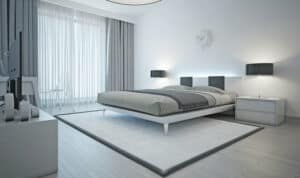Even though we buy furniture for practical purposes like seating, working, or eating, it also has a vital role in communicating about us as people living in a particular space.
From this perspective, a furniture style is a deliberate choice regarding the impression you want a space to make. Do you prefer your home to feel and look like homes of a past era, represent an epoch of change, or denote a consciousness about the use of resources and protecting the environment?
To make things easier, we will focus on the three main styles: traditional, modern, and contemporary. We will then provide examples of categories under each major style.
Traditional: Matching the Conventional Notions
In her article published by Spruce.com, Kristin Hohenadel writes, “Traditional interior design is a popular style of décor that is based largely on 18th- and 19th-century European styles and conventional notions of what a home looks like.”
She notes that the types of décor, color pallets, textiles, and furniture used in traditionally designed rooms are familiar and reference history instead of current trends.
Camille Smith of HGTV agrees with Hohenadel noting, “Timeless rather than trendy, traditional style is a tried-and-true look that’s ever-evolving, mixing vintage and antique finds with a few of-the-moment accessories for a lasting look that truly never goes out of style.”
Smith adds that when you enter a space furnished using traditional style furniture, you can expect velvet, linen, and silk upholstery. Detailed dark wood is another primary feature of the style. The main objective is to exude a sense of glamor and history.
Traditional Style Sub-categories
Within the traditional style, there are several other categories, including the following:
- American Empire: denotes a style inspired by the First French Empire period under the rule of Napoleon. The style is mainly characterized by dark and heavy woods (usually mahogany), clean lines, decorated feet, and upholstery in a single color.
- Arts and Crafts: the sub-categoryinspired by the famous American furniture manufacturer Gustav Stickley. Pieces based on this design are characterized by accents like curved boards, inlay work, and carvings.
- Art Dec:is generally simple, symmetrical, and planar (straight, smooth, level, flush, or even), with unvaried duplication of features.
- Asian: usesnatural materials, floral motifs, and simple and clean lines.
- Chippendale: Sarah Lyon of TheSpruce.com writes, “Chippendale pieces are characterized by several key characteristics: S-curves, gothic influenced arches, Queen Anne cabriole legs, heavy Chinese influences, and pagoda elements in cabinet pediments.”
- Federal: is inspired by the Federal Era of American politics between 1789 and 1823. The style is distinguishable by its light construction, tapered legs, graceful straight lines, and contrasting veneers.
- French: is characterized by pieces with curves forming what often looks like the letter The furniture’s strong construction is softened by floral designs on its surfaces.
- Jacobean: differs from the other furniture produced in its period because it is hardly ornamented, with the only decoration usually found on the legs.
- Louis XVI: is inspired by styles popular in France during the rule of Louis XVI. The chairs aremostly straight and upright, with clean square edges and lines, while tables tend to be rectangular, square, kidney, round, or oval-shaped.
- Pennsylvania Dutch: Accordingto Study.com, one of the distinctive characteristics of this type of furniture is that it was “painted in bright and colorful scenes of daily life, with birds or other animals, or patterns of geometric shapes.”
- Queen Ann: is inspired by furniture made during William III’s reign in England. The type of furniture is identifiable by its fiddle-backed chairs, drake or pad feet, cabriole legs, and bat-wing-shaped drawer pulls.
- Sheraton: is a style named after the renowned English furniture designer and author Thomas Sheraton. The upholstery is usuallyplain, flowered, or striped, with damasks, silks, or satins. You’ll notice that pieces made using the Sheraton style have smooth, elegant proportions and straight lines, round and slender legs, and light construction.
- Vintage: denotes any piece that is more than 20 yearsold and has been restored.
- Victorian: Study.com saysthis “… furniture is characterized by ornate carvings, dark woods, and heavy luxurious fabrics.”
- William and Mary: accordingto Encyclopedia Britannica, “Characteristics of William and Mary style are the scallop shell, C- and S-scrolls, and the acanthus leaf of classical tradition.”
Modern: A Rebellion Against The Past
In their article published on HouseBeautiful.com, Sienna Liver and Kelly Allen attempt to define the modern design style. They note that even though the modern and contemporary styles are often mistakenly perceived to be the same, they are actually two different things.
According to Liver and Allen, the modern furniture style can be traced back to the early to mid-20th century, when designers seemed to be shunning the decorative styles of the past. Consequently, the furniture style is characterized by clean lines, neutral colors, natural materials, and low and long furniture.
The modern furniture style is mainly used when designing furniture that will be placed in open-plan settings where its features are enhanced by abundant sunlight.
Sub-Categories of the Modern Style
Below are the most common sub-categories of the modern furniture style:
- American Design: is characterized by solid wood pieces and natural fibers. Look out for the natural, cool, and warmbrown, dark chocolate, and yellowish sand colors in practical pieces that follow traditional shapes.
- Casual Luxe: is represented by luxury, personified in pieces with reflective surfaces made from exotic timber, precious metals, glass, mirrors, silk, and velvet.
- Minimalism: as the name suggests, this style is characterized by clean lines and simplicity. The furniture is functional and often avoids superfluous decoration and ornamentation.
- Relaxed modern: attempts to bring together the elements of clean lines, comfort, and durability using natural materials. So, you can expect natural warm wood tones and grayfabrics when you enter a home furnished using this style.
- Retro: represents the returnof a once popular style that had lost popularity.
- Rustic: combines various styles going into the past and tapping into the future. The piecesconstructed from metal, wood, leather, or fabric using this style are designed to look raw, rough, and unfinished.
- Shabby Chic: is represented by antique furniture, usually accompanied by clean white fabrics. Other characteristics include a distressed furniture look, ruffles, subdued tones, and floral patterns.
- Urban collective: attempts to present furniture that looks like a DIY job accomplished using reclaimed materials. It’s characterized by the use of everyday fabrics and lots of cushions that represent a shared space.
Contemporary: Styles and Trends of the Present
In her article published by USNews.com, Devon Thorsby describes the contemporary furniture style. She writes, “Contemporary design reflects the design trends of the moment and is often a combination of other existing design styles to mirror the common preferences of the current time.”
Thorsby adds that since contemporary design reflects the popular choices of the current period, it doesn’t immediately invoke thoughts of a certain period or style exclusively.
Abe Abbas of TheSpruce.com notes, “Contemporary style furniture is easily recognizable for its simple and sleek lines.” It also tends to steer away from intricate carving and detail.
If you walk into a space designed using the contemporary style, you’ll find furniture with clean lines and square edges made from natural or synthetic materials.
The popular colors for this style include black, taupe, gray, and white. However, contemporary style designers are not afraid to be bold and use red, lemon, and yellow.
Unlike the traditional and modern styles, the contemporary style doesn’t have any elaborate sub-categories.
Choosing a Style
Writing for the home decorating website MyDomaine.com, Gabrielle Savoie notes, “… while it’s easy to fall into the trap of following a specific trend – whether that be midcentury, Scandinavian, or traditional – the most impactful spaces are the ones that effortlessly combine elements from multiple periods, styles, and places.”
This implies that while we can theoretically distinguish the various furniture styles, it doesn’t necessarily mean that when you go with one style, the other becomes off-limits. Instead, the different styles can be used to complement each other.
Vera Dordick of HomeEdit.com advises that the best way to determine a furniture style that works for you is to focus on what you like and how it makes you feel.
For Robin Layton of MyMove.com, one of the most important elements when selecting a style is the nature of your space. The items already in the space will give you an idea of what will work and what will not.
She advises, “You need to be comfortable in your space, and if you are an entertainer, you want your guests to be wowed by your decorating chic, not put off by forced perfection or an over-designed, cluttered space.”






